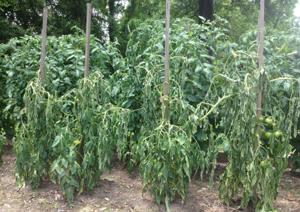
As summer approaches, LSU plant specialist Raj Singh is warning growers of tomatoes, peppers and other vegetables to beware of a particularly deadly bacteria that may be lurking underground.
Caused by soil-born bacterium, Southern bacterial wilt is a plant disease that can decimate solanaceous vegetables like peppers, tomatoes and eggplant.
While the bacteria can remain present in the soil for up to five years, it can kill a vegetable plant within a week.
“Southern bacterial welt is a soil-born disease; that means it can stay in the soil for several years even in the absence of the host,” Singh said. “So if you had this disease in the previous year and you’re planting another solanaceous crop like eggplants, peppers or tomatoes, then the bacteria is already there and they will get the infection from the previous year.”
Southern bacterial wilt can spread easily, from contaminated soil under a boot or shoe to quickly through the irrigation systems set up in many gardens.
With warm temperatures and rainy weather, Singh said, Louisiana has the perfect conditions for Southern bacterial wilt to thrive.
“It’s one of those diseases that spreads very easily and develops very easily. Our environment is so conducive and weather conditions are so conducive for it to develop and spread,” he said. “At the same time, it’s very hard to manage.”
Because there is no effective treatment to kill the bacteria, tomato farmers or home growers have limited measures they can implement to prevent bacterial wilt from impacting their vegetables.
“We don’t have any chemical control management for this disease, so it takes a combination of good agronomic practices to manage the disease,” Singh said. “So the idea here is to keep the bacteria population low enough that it’s unable to cause that clogging of the water channels and cause the plants to wilt.”
To keep an eye out for Southern bacteria wilt, Singh said, growers should check plants in the evening to see if they’re wilting.
“Wilting is caused by a lack of water, but the lack of water is because the water channels are clogged,” he said. “It will take some time for the pathogen to clog the channels, so if you start seeing the plants are wilting more and more on that second or third day, that means you have that bacterial wilt.”
Singh said now is a good time to check for Southern bacterial wilt because its worst impacts to overall yield come if found early in the season.
“It can be pretty damaging because the bacteria can spread with irrigation water, so if you have 20 tomato plants and you have this disease, you may not harvest any fruit because it’s coming early in the season.”
While there isn’t much to be done once in your vegetable bed, Singh said, preventative measures such as a deep clean of all garden equipment and contained beds can help separate infected areas and prevent spread.
“It’s a serious disease for solanaceous vegetables; it’s devastating because once you have that disease in your bed then chances are you won’t enjoy your tomatoes,” he said.

Leave a Reply